Integrations
 New Google Sheet
New Google Sheet
Description
New Google Sheet Node serves for creation of a new Google sheet on a specified Google account. It requires two entries: users e-mail address and a name which will be given to the newly created sheet.
Hint
For a detailed walkthrough see the step-by-step guide .
Parameters
In order to succesfully create a new Google spreadsheet, two parameters are required as user entries.
Parameter |
Type |
Description |
|---|---|---|
Sheet name |
string |
The entered string will be used as a name for the newly created spreadsheet, e.g. Test_sheet. |
string |
E-mail address with an access to Google worspace, e.g. john.doe@gmail.com. The new spreadsheet will be created in spreadsheets on this account. |
Step-by-step guide
The New Google Sheet Node is located in the INTEGRATIONS submenu of the BUILD menu. In order to activate it, click on the INTEGRATIONS button on the left panel…
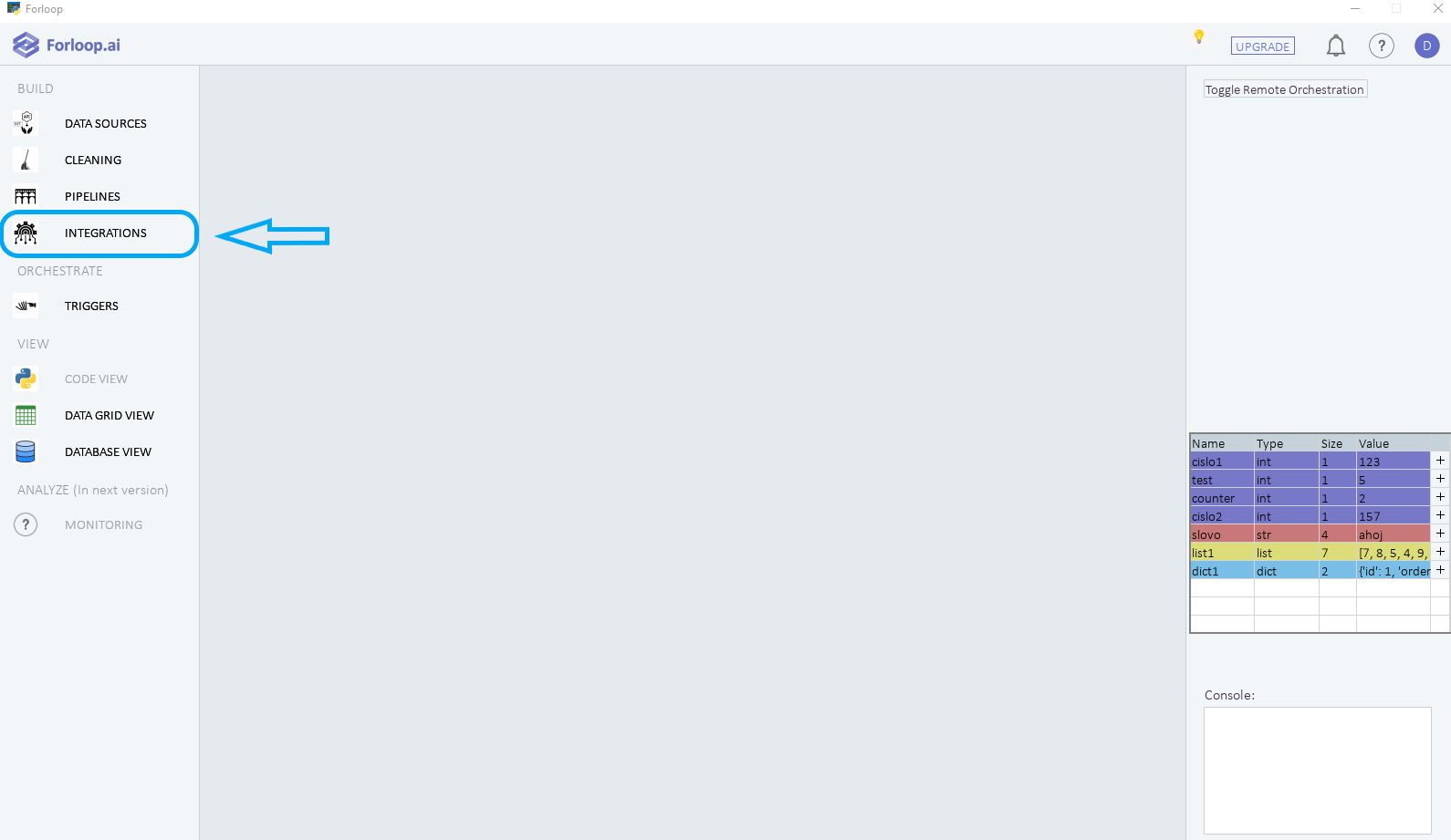
and then on the New Google Sheet option in the pop-up menu…
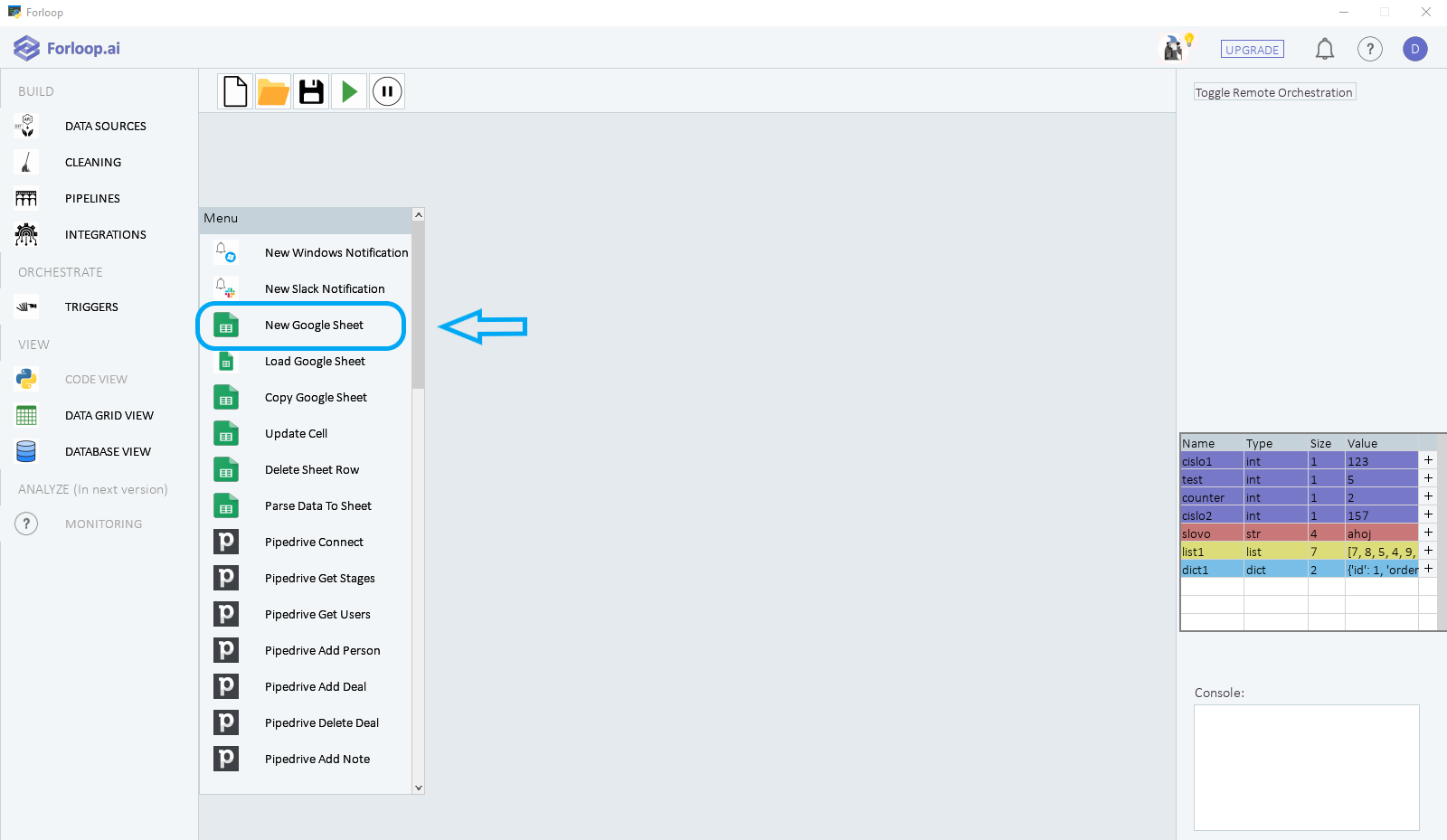
A new icon labeled NewGoogleSheet will appear in the working space. After a click/tap on this icon two entry boxes will appear in the upper right corner as shown below.
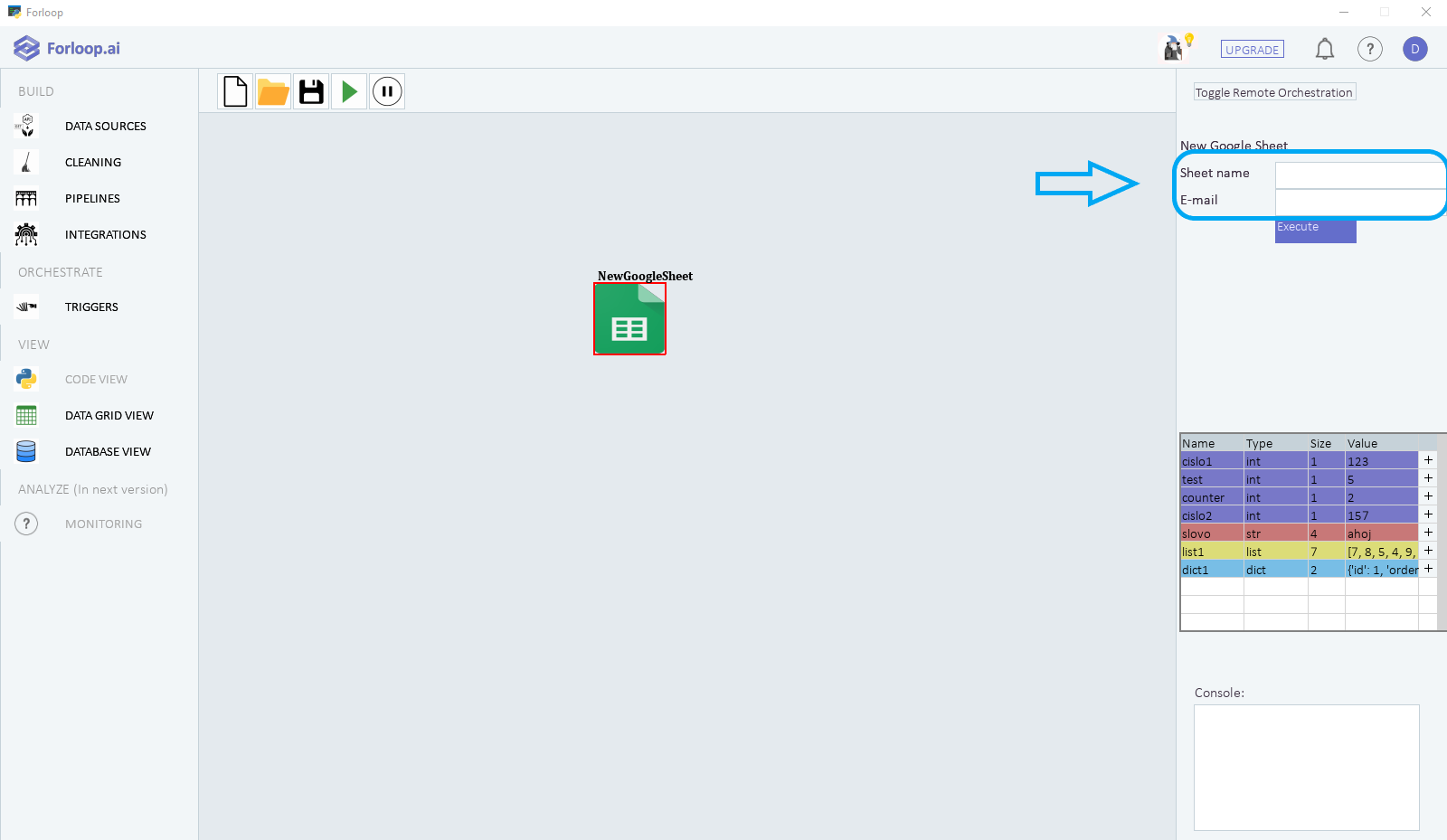
The first entry requires an e-mail address to which the newly created Google sheet will be paired and the second one stores the name of the sheet.
Important
E-mail address must be hosted by Google!
Finally click on the Execute button to finish the creation of your new Google sheet.
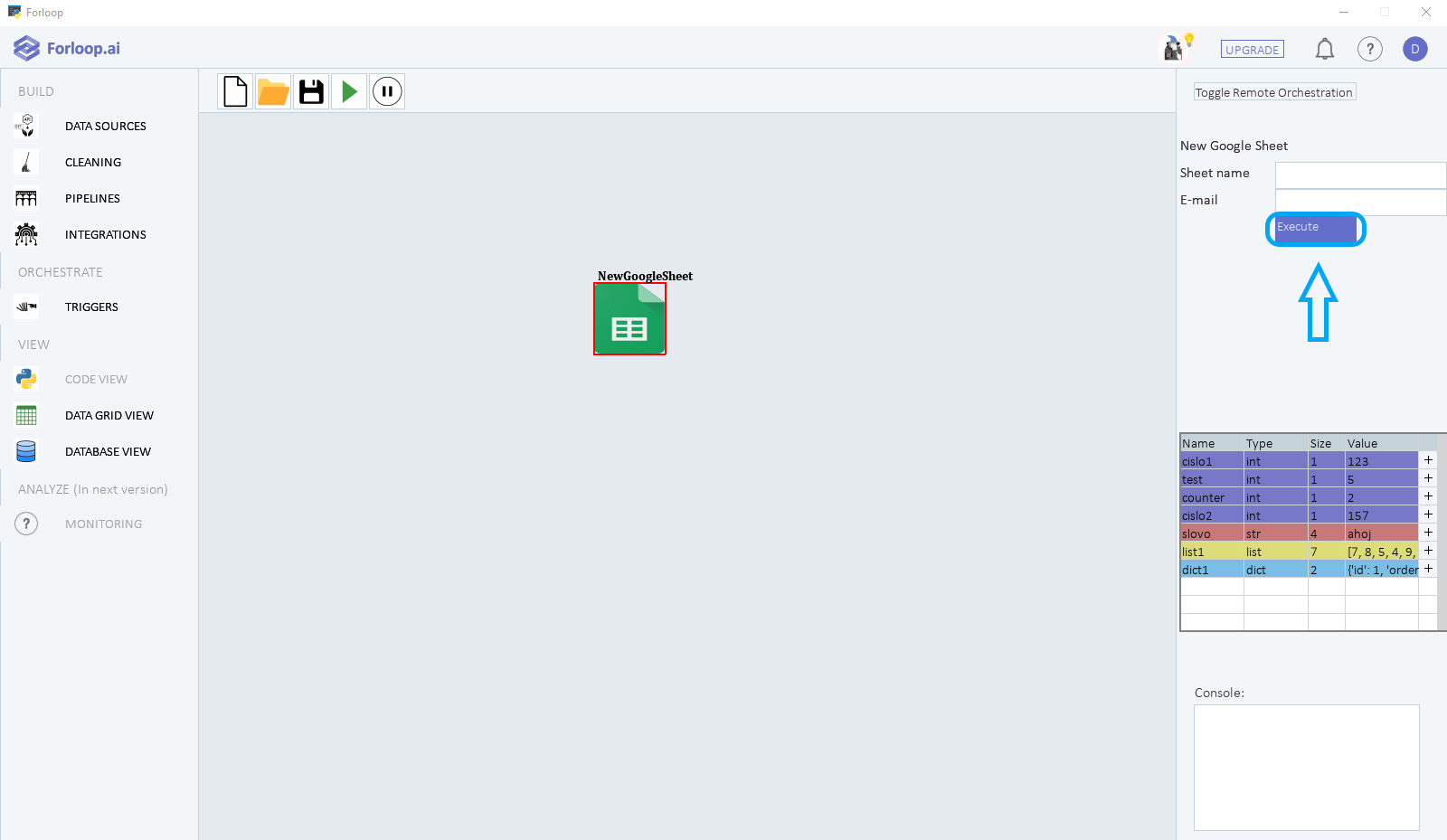
That’s it!
Note
It is advisable to check your Google account for the newly created sheet so as to avoid any inconvenience during the follow up work.
 Load Google Sheet
Load Google Sheet
Description
Load Google Sheet Node serves, as the name suggests, for loading a Google sheet into Forloop. It requires three entries: Google file ID, sheet name and new variable name. It then creates a new Forloop object with an interactive icon which can be used for further analysis in the same manner as a data table.
Hint
For a detailed walkthrough see the step-by-step guide.
Parameters
In order to succesfully load a Google spreadsheet, three parameters are required as user entries.
Parameter |
Type |
Description |
|---|---|---|
Sheet ID |
string |
Google file ID is a unique key defining the specific spreadsheet. It can be found in sheets URl, e.g.: https://docs.google.com/spreadsheets/d/ 1FApy2bGcFFmpg-lTNS8HWpq-fpHlGcJhvq-DXhr4b1o /edit#gid=0 |
Sheet name |
string |
The name of the loaded spreadsheet. It is essential to write the name in its full form, i.e. if the name is ‘test_sheet’ then writing ‘test sheet’ will not work. |
New variable name |
string |
A name that will be used for the newly created icon of the loaded spreadsheet. Therefore this field required an arbitrary string. |
Step-by-step guide
The Load Google Sheet handler is located in the INTEGRATIONS submenu of the BUILD menu. In order to activate it, click on the INTEGRATIONS button on the left panel…

and then on the Load Google Sheet option in the pop-up menu…
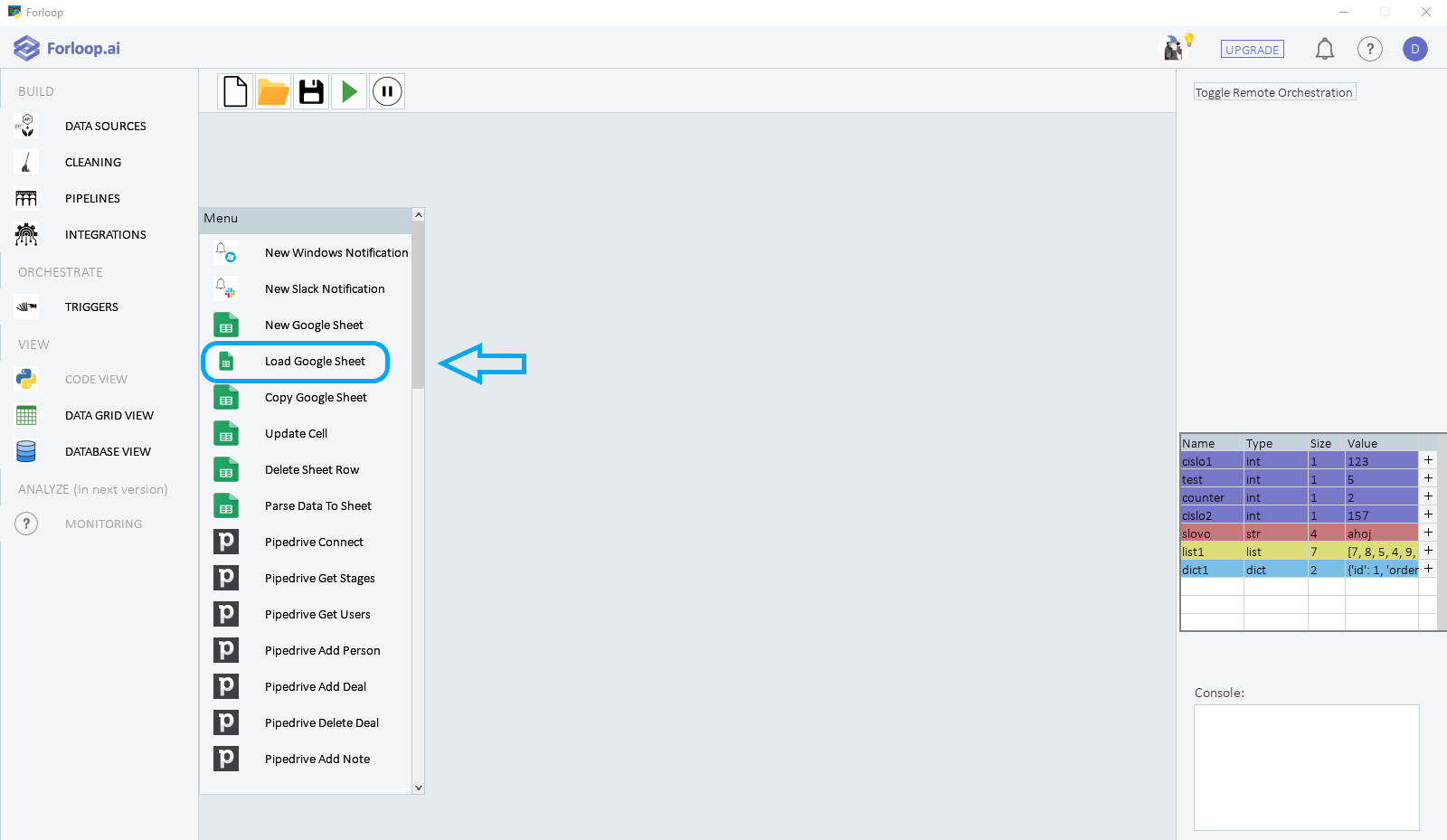
A new icon labeled LoadGoogleSheet will appear in the working space. After a click/tap on this icon two entry boxes will appear in the upper right corner as shown below.
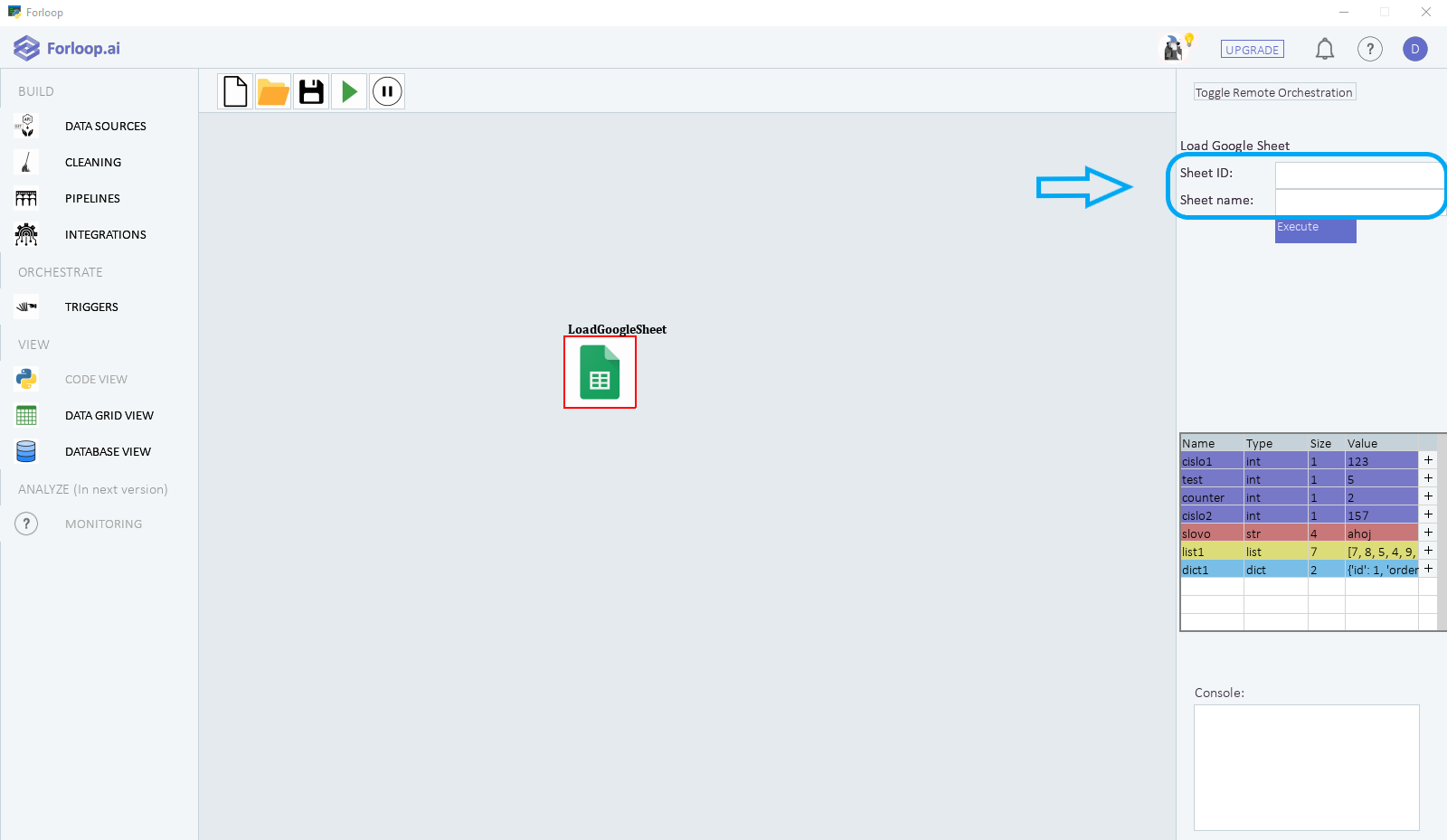
The first entry requires the Google file ID of the sheet to be loaded and the second one the sheets name.
Important
Google file ID is a unique key defining the specific spreadsheet. It can be found in sheets URl, e.g.: https://docs.google.com/spreadsheets/d/ 1FApy2bGcFFmpg-lTNS8HWpq-fpHlGcJhvq-DXhr4b1o /edit#gid=0
After filling in both entry boxes and clicking the Execute button beneath them…
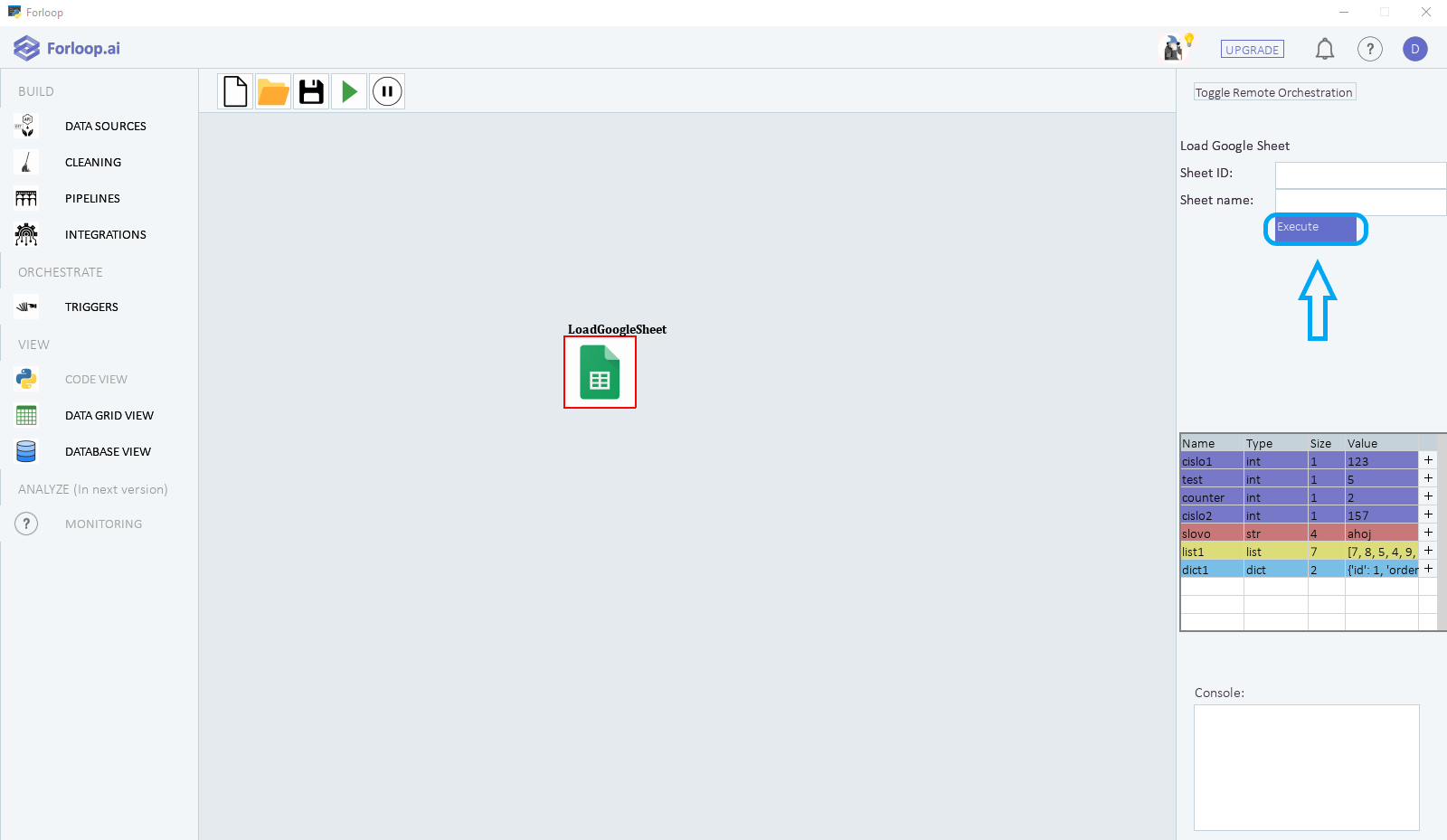
a new icon named as the original spreadsheet will appear in the work space.
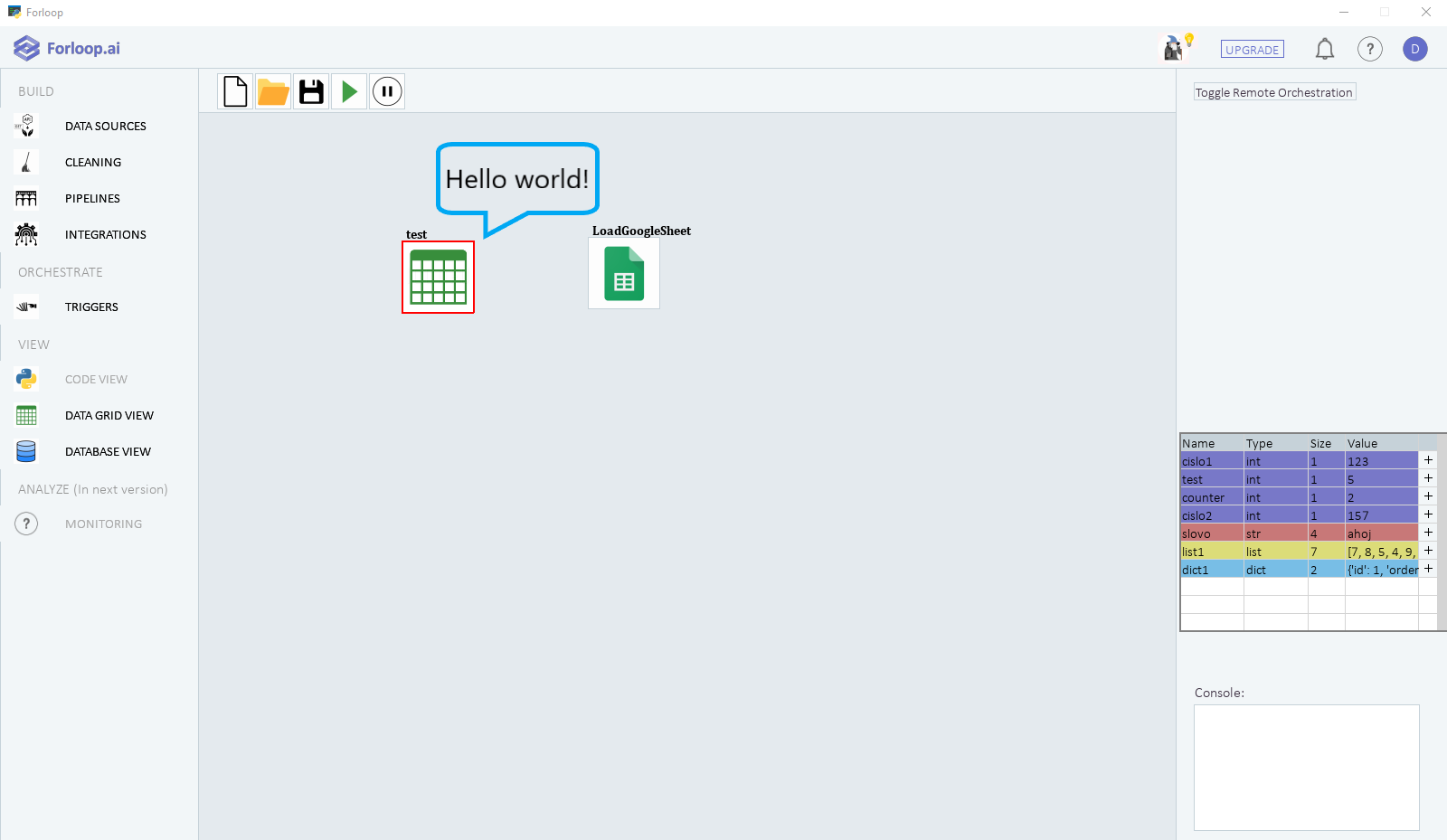
This icon serves as a gateway to the object containing the loaded spreadsheet so it can be handled in the similar manner as e.g. loaded Excel file or other data table object. For example the data stored in the sheet can be viewed as table by using Data Grid View.
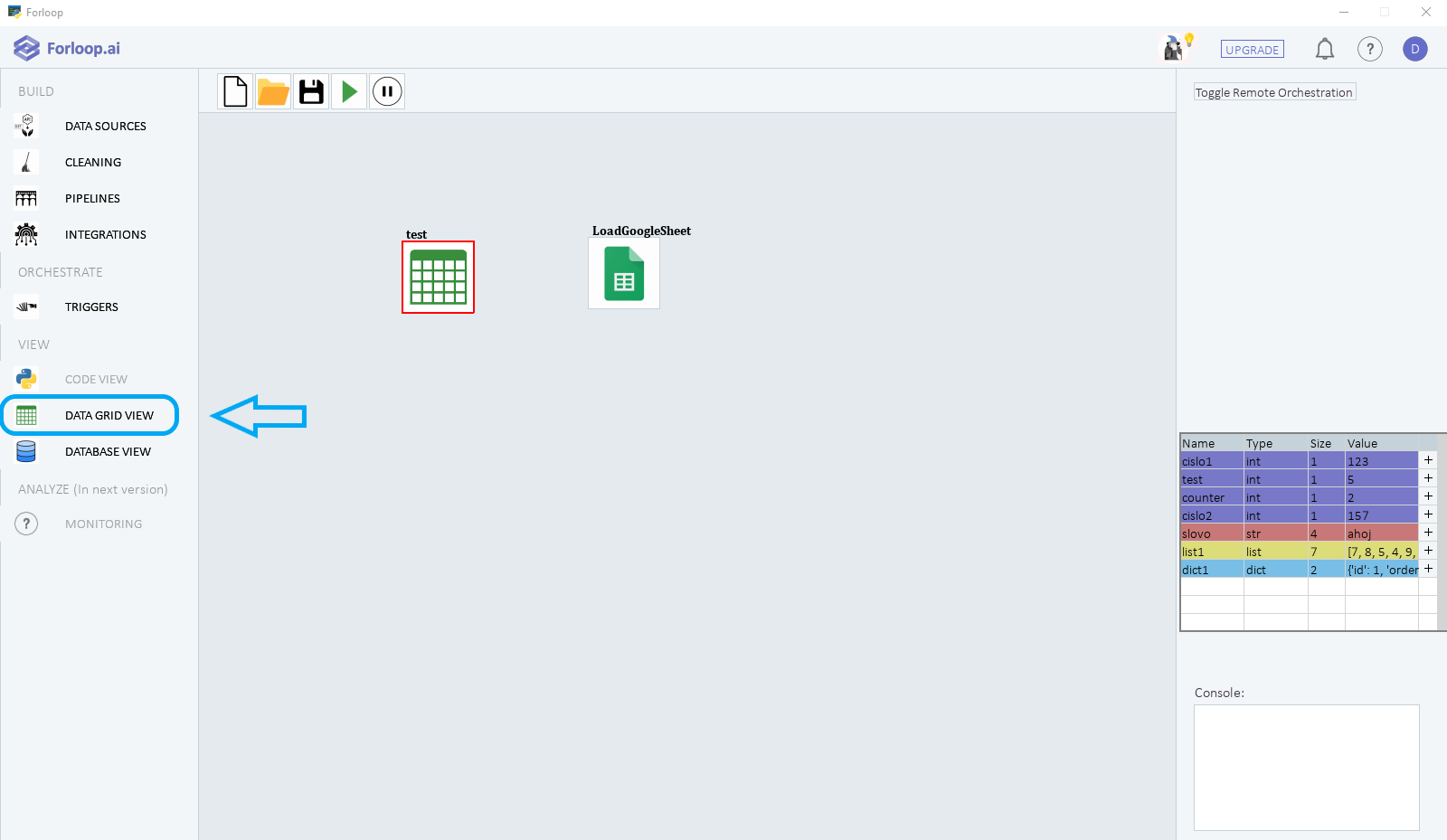
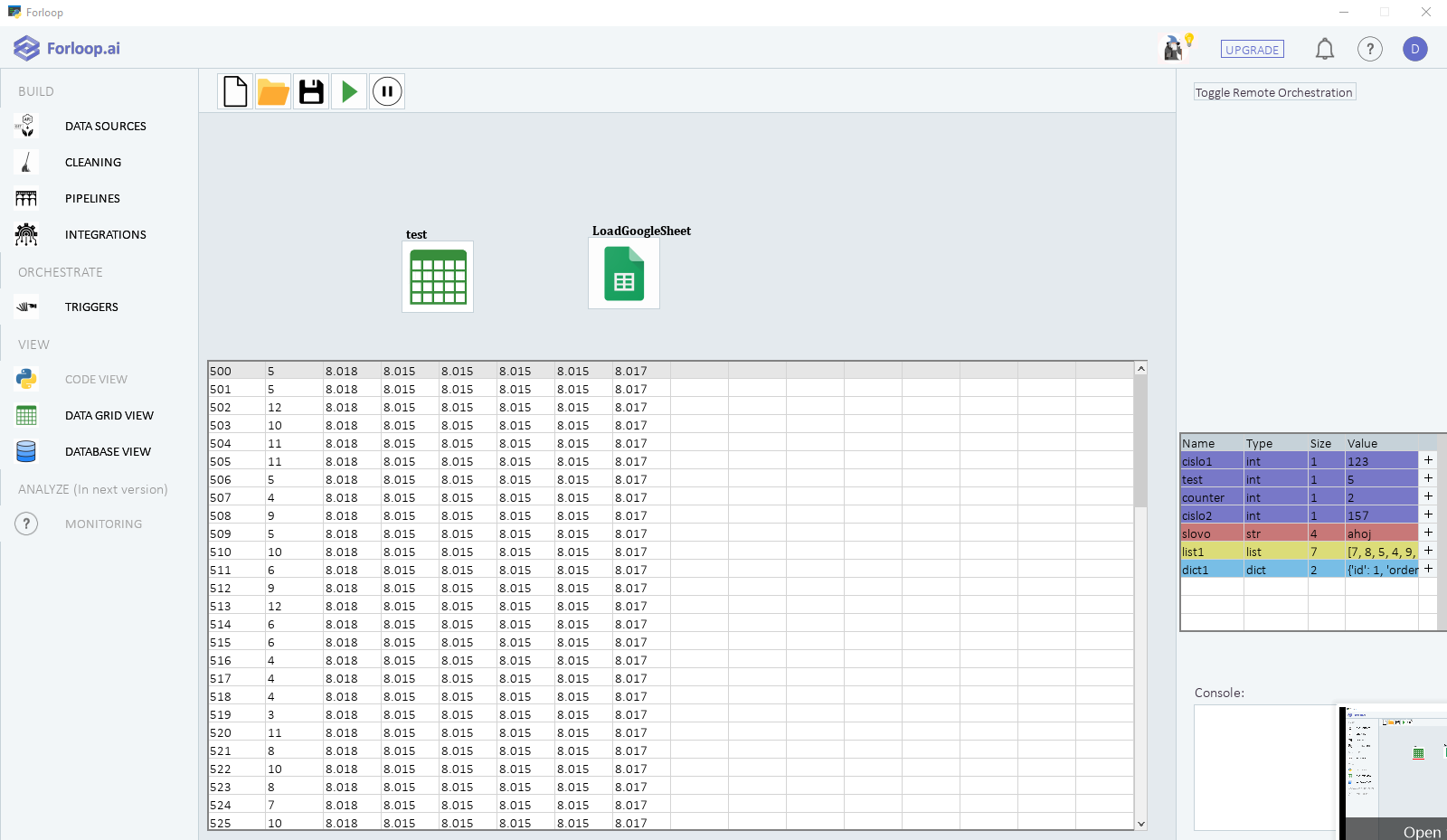
 Copy Google Sheet
Copy Google Sheet
Description
Copy Google Sheet Node makes a copy of the spreadsheet identified by Sheet ID for the Google account belonging to the E-mail address. An arbitrary name can be chosen for such copy.
Hint
For a detailed walkthrough see the step-by-step guide.
Parameters
In order to succesfully load a Google spreadsheet, three parameters are required as user entries.
Parameter |
Type |
Description |
|---|---|---|
Sheet ID |
string |
Google file ID is a unique key defining the specific spreadsheet. It can be found in sheets URl, e.g.: https://docs.google.com/spreadsheets/d/ 1FApy2bGcFFmpg-lTNS8HWpq-fpHlGcJhvq-DXhr4b1o /edit#gid=0 |
Sheet copy name |
string |
The entered string will be used as a name for the newly created copy of the original spreadsheet, e.g. Copied_sheet1. |
string |
E-mail address with an access to Google worspace, e.g. john.doe@gmail.com. The copy of the original spreadsheet will be created in spreadsheets on this account. |
Step-by-step guide
 Update Cell
Update Cell
Description
Update Cell Node can be used for entering new data in a specific single cell of a spreadsheet or altering already existing data in such a cell.
Hint
For a detailed walkthrough see the step-by-step guide.
Parameters
Update Cell Node requires 4 parameters as user entries, all of which must be filled in.
Parameter |
Type |
Description |
|---|---|---|
Sheet ID |
string |
Google file ID is a unique key defining the specific spreadsheet. It can be found in sheets URl, e.g.: https://docs.google.com/spreadsheets/d/ 1FApy2bGcFFmpg-lTNS8HWpq-fpHlGcJhvq-DXhr4b1o /edit#gid=0 |
Sheet name |
string |
The name of the spreadsheet, whose cell is going to be updated. It is essential to write the name in its full form, i.e. if the name is ‘test_sheet’ then writing ‘test sheet’ will not work. |
Cell name |
string |
Specifies which cell will get updated, e.g. ‘B4’. |
Value |
int/float/list/dict/str/bool |
Data to be inserted into the specified cell. |
Step-by-step guide
 Delete Sheet Row
Delete Sheet Row
Description
Delete Sheet Row Node serves to deletion of a single row or a series of rows in a Google spreadsheet.
Hint
For a detailed walkthrough see the step-by-step guide.
Parameters
Delete Sheet Row Node requires 3 parameters (Sheet ID, Sheet name, Start row number) to delete a single row and 4 parameters (Sheet ID, Sheet name, Start row number, Stop row number) to delete a series of rows.
Parameter |
Type |
Description |
|---|---|---|
Sheet ID |
string |
Google file ID is a unique key defining the specific spreadsheet. It can be found in sheets URl, e.g.: https://docs.google.com/spreadsheets/d/ 1FApy2bGcFFmpg-lTNS8HWpq-fpHlGcJhvq-DXhr4b1o /edit#gid=0 |
Sheet name |
string |
The name of the spreadsheet, whose row(s) is/are going to be deleted. It is essential to write the name in its full form, i.e. if the name is ‘test_sheet’ then writing ‘test sheet’ will not work. |
Start row number |
integer |
A number of the row to be deleted or the initial row of the series to be deleted. The numbering preserves the Python logic, ie. the first row corresponds to number 0! |
Stop row number |
integer |
A number of the last row of the series of rows to be deleted. If left blank, only a single row, i.e. row no. Start row number + 1 (Python logic), will be deleted. |
Step-by-step guide
 Parse Data To Sheet
Parse Data To Sheet
Description
Parse Data To Sheet Node enables us to insert data from a text file (.txt or .csv) into a spreadsheet.
Hint
For a detailed walkthrough see the step-by-step guide.
Parameters
Parse Data To Sheet Node requires at least 3 parameters (Filename, Sheet ID, Sheet name) to succesfully insert the data into the specified spreadsheet.
Parameter |
Type |
Description |
|---|---|---|
Filename |
string |
A path to the data file must be filled in into the Filename entry either manually or via file explorer by clicking the Look up file button below the entry line. |
Sheet ID |
string |
Google file ID is a unique key defining the specific spreadsheet. It can be found in sheets URl, e.g.: https://docs.google.com/spreadsheets/d/ 1FApy2bGcFFmpg-lTNS8HWpq-fpHlGcJhvq-DXhr4b1o /edit#gid=0 |
Sheet name |
string |
The name of the spreadsheet into which should the data be loaded. It is essential to write the name in its full form, i.e. if the name is ‘test_sheet’ then writing ‘test sheet’ will not work. |
Delimiter |
string |
The delimiter of the data file. For example for a .csv file the input should be “,” without the quotation marks. If left blank a .txt file separated with a space is expected. |
Starting cell |
string/integer |
Starting point for the parsed data, i.e. this cell will be an upper left corner of the inserted data. If left blank the “A1” cell will be the starting point. |
Step-by-step guide
 Pipedrive Connect
Pipedrive Connect
Description
Pipedrive Connect Node creates the connection with the pipedrive specified by the entered arguments, i.e. Company domain name and Pipedrive token.
Hint
For a detailed walkthrough see the step-by-step guide.
Parameters
Pipedrive Connect Node requires at 2 parameters to make a successful connection.
Parameter |
Type |
Description |
|---|---|---|
Company domain name |
string |
A name of the company domain connecting to the pipedrive, e.g. forloop. |
Pipedrive token |
string/integer |
A special key required for authentification before the connection to the pipedrive. En example of such token: ah0jjaks3masjas3mamd0bre. |
Step-by-step guide
 Pipedrive Get Stages
Pipedrive Get Stages
Description
Pipedrive Get Stages Node gets stages from the connected pipedrive and saves them as a new variable.
Hint
For a detailed walkthrough see the step-by-step guide.
Parameters
Parameter |
Type |
Description |
|---|---|---|
Save as |
string |
A name of the newly created variable containing the data from the pipedrive, e.g. ‘stages_dict_1’. |
Step-by-step guide
 Pipedrive Get Users
Pipedrive Get Users
Description
Pipedrive Get Users Node retrieves the list of users from the connected pipedrive and saves it as a new variable.
Hint
For a detailed walkthrough see the step-by-step guide.
Parameters
Parameter |
Type |
Description |
|---|---|---|
Save as |
string |
A name of the newly created variable containing the data from the pipedrive, e.g. ‘users_dict_1’. |
Step-by-step guide
 Pipedrive Add Person
Pipedrive Add Person
Description
Pipedrive Add Person Node inserts a new user data into the connected pipedrive.
Hint
For a detailed walkthrough see the step-by-step guide.
Parameters
Parameter |
Type |
Description |
|---|---|---|
Name |
string |
The name of the new user, e.g. ‘Patrick Jane’. |
string |
New users e-mail address, e.g. red.john@forloop.ai |
|
Phone number |
string/integer |
New users phone number, e.g. +420111222333. |
Step-by-step guide
 Pipedrive Add Deal
Pipedrive Add Deal
Description
Pipedrive Add Deal serves to enter a deal (basically a post request) to the connected pipedrive.
Parameters
Pipedrive Add Deal Node requires 3 parameters which form a payload of the post request:
Parameter |
Type |
Description |
|---|---|---|
Title |
string |
The title of the entered deal, e.g. ‘Damn goog deal!’ |
Stage ID |
string/integer |
An id code of the deal used for further identification. |
User ID |
string/integer |
An id of the user inserting the deal. |
 Pipedrive Delete Deal
Pipedrive Delete Deal
Description
Pipedrive Delete Deal Node deletes the deal specified by the Deal ID from the connected pipedrive.
Hint
For a detailed walkthrough see the step-by-step guide.
Parameters
Parameter |
Type |
Description |
|---|---|---|
Deal ID |
string/integer |
An id code of the deal to be deleted. |
Step-by-step guide
 Pipedrive Add Note
Pipedrive Add Note
Description
Pipedrive Add Note serves to enter a note to the deal in the pipedrive specified by its Deal ID.
Hint
For a detailed walkthrough see the step-by-step guide.
Parameters
Parameter |
Type |
Description |
|---|---|---|
Content |
string |
The content which will be added as a note to the specified deal, e.g. “A deal is never late, nor is it early, it arrives precisely when it means to.” |
Deal ID |
string/integer |
An id code of the deal to which the note will be connected. |
Step-by-step guide
 Airtable Connect
Airtable Connect
Description
Airtable Connect Node establishes a connection to the specified Base on https://airtable.com.
Hint
For a detailed walkthrough see the step-by-step guide.
Parameters
Parameter |
Type |
Description |
|---|---|---|
API key |
string |
A 17 character string containing letters and numbers which enables the usage of the API for a specific account on https://airtable.com. |
Base ID |
string |
A 17 character string containing letters and numbers that specifies a Base |
Step-by-step guide
 Airtable Add Record
Airtable Add Record
Description
Adds a record (a row of data) to the connected AirTable.
Parameters
Airtable Add Record requires 2 parameters:
Parameter |
Type |
Description |
|---|---|---|
Table name |
string |
A name of the AirTable table in which the entry will be inserted. |
Value |
dictionary |
A dictionary containing the AirTable tables column names as keys and entered values as dictionary values, e.g. {‘Name’:’Gandalf’,’Surname’:’Stormcrow’,’Age’:24000, ‘Occupation’:’Wizard’} |
 Airtable Parse Data
Airtable Parse Data
Description
AirTable Parse Data either appends the data to the selected Airtable or overwrites it, i.e. deletes all the data already present and appends the new data.
Parameters
3 parameters are required:
Parameter |
Type |
Description |
|---|---|---|
Table name |
string |
A name of the AirTable table in which the entry will be inserted. |
Filename |
string |
A path to the .csv file containing the data to be loaded, e.g. /Users/lord_voldemort/Desktop/my_evil_data.csv. |
Operation |
combobox |
Append → the data from the loaded file will be added to the end of the table; Overwrite all data in the table will be overwritten (Be careful as this method might lead to a data loss!). |
 Airtable Read Table
Airtable Read Table
Description
Reads the Airtable specified by its name (and the API key and base ID provided to the connection node) and saves its contents as a new variable in the variable explorer in the form of the list of dictionaries.
Parameters
2 parameters are required:
Parameter |
Type |
Description |
|---|---|---|
Table name |
string |
A name of the AirTable table to be read. |
Save as |
string |
A name of the new variable which will contain the data from the Airtable, e.g. my_lovely_new_var. |